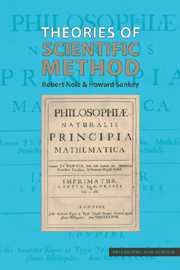Book contents
- Frontmatter
- Contents
- Abbreviations
- Acknowledgements
- Introduction
- I The idea of methodology
- II Inductive and hypothetico-deductive methods
- 5 Induction in science
- 6 Some justifications of induction
- 7 The hypothetico-deductive method
- III Probability and scientific method
- IV Popper and his rivals
- V Naturalism, pragmatism, realism and methodology
- Epilogue
- Notes
- Bibliography
- Index
7 - The hypothetico-deductive method
from II - Inductive and hypothetico-deductive methods
- Frontmatter
- Contents
- Abbreviations
- Acknowledgements
- Introduction
- I The idea of methodology
- II Inductive and hypothetico-deductive methods
- 5 Induction in science
- 6 Some justifications of induction
- 7 The hypothetico-deductive method
- III Probability and scientific method
- IV Popper and his rivals
- V Naturalism, pragmatism, realism and methodology
- Epilogue
- Notes
- Bibliography
- Index
Summary
As the name indicates there are at least two parts to the hypothetico-deductive (h-d) method: a hypothetico part in which a hypothesis or theory, arising from whatever source, is proposed for test, and a deductive part in which test consequences are drawn from the hypotheses. Unmentioned in the name of the method is a crucial third part in which consequences are deduced and compared with experiment or what we can observe. The consequences pass or fail when the comparison is made. In some cases the hypothesis might be invented to account for some already known fact(s); it is then tested by deducing further consequences from it, which are then subject to test. An important question arises about how the pass or fail verdict is transmitted back to the hypothesis; this creates problems for the h-d method, as will be seen. The test consequences need not be obtained only by deduction; if the hypotheses are statistical then the consequences are inferred by non-deductive, or inductive, reasoning. So a better name might be the hypothetico-inferential method, to cover both cases of deductive and non-deductive inference.
The method has had a long history from the time of Plato when it went by other names in his dialogues such as “the method of hypothesis”. It was applied to science in medieval times and since then has had a long involvement with scientific method. It became central in the nineteenth-century debate over method between Whewell and J. S. Mill. Some say its day has now come and its involvement in methodology is largely over. The task of this chapter is to spell out the nature of this method, and its strengths and weaknesses.
Information
- Type
- Chapter
- Information
- Theories of Scientific MethodAn Introduction, pp. 170 - 184Publisher: Acumen PublishingPrint publication year: 2007
Accessibility standard: Unknown
Why this information is here
This section outlines the accessibility features of this content - including support for screen readers, full keyboard navigation and high-contrast display options. This may not be relevant for you.Accessibility Information
- 1
- Cited by
